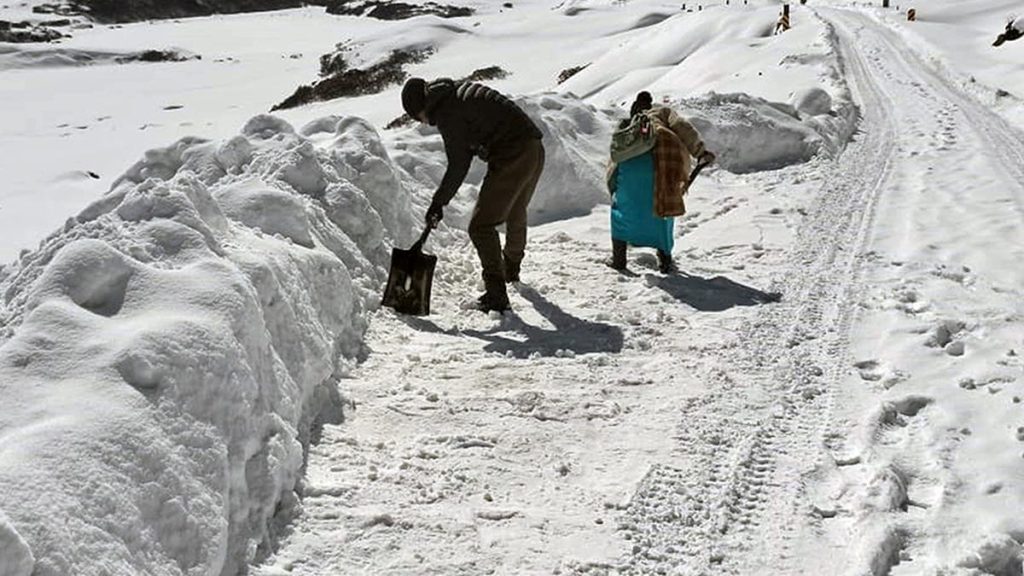
Image used for representative purpose only
| Photo Credit: ANI
A new study has revealed that a section of the eastern Himalayas in Arunachal Pradesh lost 110 glaciers in 32 years.
The study by a quartet of researchers also found that these glaciers covering an area of 309.85 sq. km disappeared at a retreat rate of 16.94 sq. km during the study period from 1988 to 2020. The retreat exposed bedrock and created glacial lakes, threatening glacial lake outburst floods (GLOFs).
Also Read:Glacial lakes rise as glaciers retreat
Glacial retreat, a key indicator of global climate change, is the process by which glaciers melt faster than new snow and ice can accumulate. The eastern Himalayas have been witness to a major GLOF – the 2023 Sikkim disaster that killed at least 55 people and destroyed a 1,200-megawatt hydropower project on the Teesta River.
Authored by Vimha Ritse, Amenuo Susan Kulnu, and Latonglila Jamir of Nagaland University’s Department of Environmental Science, and Nabajit Hazarika of the Guwahati-based Cotton University’s Department of Environmental Biology and Wildlife Sciences, the study was published in the Journal of Earth System Science.
The researchers used remote sensing and geographic information systems to map glacier boundaries, even in debris-covered areas, from Tawang to Lohit districts of Arunachal Pradesh through West Kameng, Kurung Kumey, Upper Siang, and Upper Dibang Valley districts. They also used the Randolph Glacier Inventory of Global Land Ice Measurements from Space as a reference.

They found that the number of glaciers decreased from 756 to 646 during the 32-year-long study period. The glacial cover during this period reduced by 309.85 sq. km from 585.23 sq. km, working out to a loss of a little more than 47%.
Most of the glaciers studied lie at an elevation of 4,500-4,800 metres above mean sea level, are north-facing and confined between a slope of 15° and 35°.
Third Pole
The largely snow-covered Himalayan belt is considered the ‘Third Pole’ as it has the largest collection of glaciers outside the polar regions. It serves as a freshwater source for more than 1.3 billion people living in the downstream regions.
According to the study, the Himalayan glaciers are significant in maintaining the region’s hydrological balance and the global sea level.
“Several meteorological studies on the Himalayas have reported changes in temperature and precipitation.
The temperature has increased by 1.6°C in the last century, which shows that the northwestern Himalayas have a higher rate of temperature in comparison to the global average rate,” the study said.
“Similarly, the eastern Himalayan region is warming at a rate surpassing the global average with temperature increase reported between 0.1° and 0.8°C per decade, which is notably higher than the global increase of approximately 0.74°C over the last century. The warming trend of this region is expected to continue, experiencing a temperature rise of 5-6°C and an increase in precipitation of 20–30% by the end of the century,” it said.
Overall, the Himalayan glaciers are experiencing a rapid retreat rate compared to other glaciers globally and are facing a yearly average area loss of about 0.4% as a result of climate change, the study noted.
Smaller glaciers below 5 sq. km in the Eastern Himalayas have shrunk the fastest. While rainfall patterns have been erratic, the study found no statistically significant trend in precipitation, emphasising the unpredictable nature of climate changes in the region.
“The retreat of the glaciers will drastically impact freshwater availability, distribution, and ecosystem health. It also increases the risk of GLOFs and other hazards,” Dr. Hazarika said, highlighting the importance of understanding the impacts of climate change on frozen freshwater reserves.
Published – February 04, 2025 08:54 am IST








